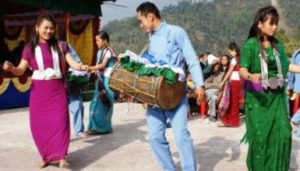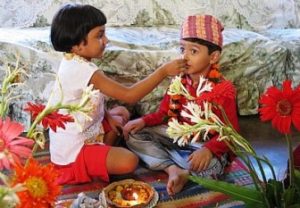[My Diwali: a collection of personal perspectives from our readers, contributors, and interns. In this piece Rebecca Tamang describes the festival as it unfolds around the hills of Darjeeling and Sikkim]
‘Jhili Mili, Jhili Mili Deusu re!’
The hills of Kalimpong, Darjeeling and Siikimare alive with the sound of a special music… the Bhailo and Deuseu caroling.
With tourists turning up in droves, the economy of the region has got the much-needed big push and the impact is visible with the preparations around Tihar (as Diwali is called in the hills) festival that started on Monday.
While the plainsmen battle one another to buy ‘dhan’ on dhanteras, the hills of the Darjeeling and siikim celebrate Kag puja.
“Tihar has deep-rooted traditions and the celebration is unique,” says Mahendra Pradhanof Ranipool in Sikkim. Tihar is a five day festival with much celebration and feasting.
On Monday, as the festivities started, the Nepali/ Gorkha community celebrated Kag (crow) Tihar by leaving food at vantage points for the crows. On Tuesday, (coinciding with Kali puja) on Kukur Tihar, dogs will be doled out a treat, garlanded and fed to their fill.
While scriptures and folklore portray the crow as a messenger of Yamraj, the god of death, dogs are believed to have powers to feel the presence of His emissaries.
On Wednesday, the hill people will be busy performing Lakshmi Puja. “The goddess of wealth is worshipped in the evening while cows, considered an incarnation of the goddess is worshipped in the morning,” explained a hill resident. It is on this day that lamps are lit.
After pujas in the evening, Bhailo singers take centre-stage. The carols, which are blessings in verse are sung at every home by roving teams for which the families offer money as a mark of respect.
Similarly boys sing Deusa but this is played from the day after Lakshmi Puja.
On the fourth day the celebrations are according to different cultural backgrounds.
Commonly Goru Puja or Ox worship is performed. Devotees of Lord Krishna perform Govardhan Puja in which a small hill shaped cow dung worshiped. This puja symbolises the act of lord Krishna when he lifted the gobhardan hill and saved millions of people and cows from floodwater.
Devotees of Newar community perform Maha Puja that is worshiping yourself. This symbolises worshiping of life. This day is also the beginning of Newar new year.
On the last day of Tihar, sisters put tika on their brothers forehead and pray to the Lord of Death, Yamaraj for their brothers long life.
Thus the five days of Tihar Festival comes to an end
“The traditions of the hills are unique. We want to showcase this to the tourists and on Lakshmi Puja day, we will be organising a Bhailo, Deusa programme at Chowrastha from 1pm onwards for the tourists,” said Sagar Tamang, the vice-chairman of Darjeeling municipality.
On November 10, the Bharatiya Gorkha Parisangh has decided to organise a Bhailo and Maruni dance show at Himalayan Kala Mandir in Darjeeling. A flower show is also currently being organised at Gorkha Dukha Niwarak Sammelan Hall (GDNS) Ground in Darjeeling.
Every house in Darjeeling is decorated with marigold flowers starting from Lakshmi Day. “This year, local marigolds are selling like anything. They are very few takers for marigolds coming from the plains. The local flower has a better fragrance and last longer, too,” said Suraj Sharma, an organiser of the show.
That’s a glimpse of My Diwali… five days of it!


